ORDO TEMPLI ORIENTIS TIMELINE
1855 (June 28): Theodor Reuss was born.
1875 (October 12): Aleister Crowley was born in Leamington Spa, Warwickshire, Britain.
1901–1902: Reuss obtained charters to operate several high-degree masonic rites in Germany.
1902: Reuss began issuing the periodical Oriflamme.
1904 (April 8–10): Crowley received The Book of the Law in Cairo, Egypt.
1906 (January 22): The date of the earliest constitution of the “Ancient Order of Oriental Templars,” likely produced closer to 1912.
1910: Reuss granted Aleister Crowley a charter for the “Antient and Primitive Rite.”
1912 (April 21): Reuss granted Crowley a charter for Ordo Templi Orientis (OTO) and designated him National Grand Master General for Britain and Ireland. Reuss also designated Crowley “General Representative” for America around this time.
1912 (June 1): A British branch of OTO, “Mysteria Mystica Maxima” or M\M\M\, was established in London.
1912 (September): Reuss announced the existence and mission of OTO, as well as Crowley’s status, in a “Jubilee” issue of Oriflamme. Crowley concurrently announced the “Order of Oriental Templars” and its British branch, M\M\M\, in the September issue of his periodical The Equinox.
1913: Crowley penned “Ecclesiæ Gnosticæ Catholicæ Canon Missæ,” the Gnostic Catholic Mass, as the “central ceremony” of OTO.
1913: The first local Lodge of OTO was established in London.
1913 (December 20): Crowley issued an OTO charter to James Thomas Windram for South Africa, leading to the formation of two Lodges.
1913–1914 (c.): Crowley revised OTO’s initiation rites up until the VI°.
1914: Crowley published a manifesto for the British branch of OTO, “Manifesto M\M\M\”.
1915 (January 1): Crowley issued a charter to Charles Stansfeld Jones, appointing him OTO representative in Vancouver.
1915 (November 15) : J.T. Windram issued an OTO charter for Australia to Frank Bennett.
1917 (January 22): Reuss announced an “Anational Grandlodge” as the new headquarters of OTO in the utopian commune Monte Verità in Ascona, Switzerland.
1917 (August 15–25): Reuss held an OTO “Anational Congress” at Monte Verità.
1918: Reuss published Crowley’s Gnostic Mass in German under the auspices of Ecclesia Gnostica Catholica (EGC).
1918 (March): The first English-language publication of the Gnostic Mass, in The International.
1919 (March 21): The Equinox III (1) was published. This issue comprised documents related to the organization and mission of OTO.
1921 (July): Reuss issued a multinational charter for OTO in North America to C.S. Jones, and a national charter for Germany to Heinrich Tränker.
1921 (September 3): Reuss issued an OTO charter to Carl William Hansen, alias Ben Kadosh, for Denmark.
1923 (October 28): Theodor Reuss died.
1924 (December): Crowley formally accepted the position of Outer Head of the Order (OHO) of OTO with the support of Jones and Tränker.
1925 (August): The Conference of Grand Masters was held in Weida, Germany.
1935: Wilfred Talbot Smith, working with Jane Wolfe, established the Agape Lodge of OTO in Southern California.
1940 (April 8): Crowley appointed Karl J. Germer as Grand Treasurer General.
1941: Germer emigrated to the U.S.
1941 (July 18): Crowley named Germer as the next OHO.
1941: Grady Louis McMurtry was initiated into the Agape Lodge of OTO.
1946 (March 22): Crowley authorized McMurtry to assume control of OTO in California in case of emergency.
1947 (December 1): Aleister Crowley died in Hastings, East Sussex. He was succeeded by Germer as OHO.
1948: Agape Lodge was closed.
1962 (October 25): Karl Germer died in West Point, California.
1968–1969: Learning of Germer’s passing, McMurtry acted on his previous authorization from Crowley and moved to reestablish OTO in California with the aid of members of the old Agape Lodge.
1977 (October 12): McMurtry chartered Thelema Lodge in Berkeley, CA, as the Grand Lodge of the reestablished OTO.
1979 (March 20): OTO was incorporated as a religious non-profit organization under the laws of the State of California.
1985 (July 12): The U.S. District Court of Northern California declared McMurtry’s OTO the rightful heir to the Crowley–Germer organization, with exclusive legal rights to Crowley’s literary legacy and the OTO name and lamen.
1985 (July 12): Grady McMurtry died.
1985 (September 21): The IX° members of OTO elected William Breeze, alias Hymenaeus Beta, as acting OHO.
1996: An International Headquarters of OTO was established, with the United States Grand Lodge (USGL) as a subordinate body.
2005: The United Kingdom Grand Lodge (UKGL) was established.
2006: The Australia Grand Lodge was established.
2014: Grand Lodges were established in Italy and Croatia.
2014 (October 10): The five National Grand Masters voted to elect Breeze as de jure OHO.
FOUNDER/GROUP HISTORY
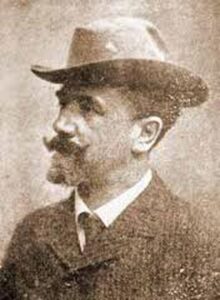
Ordo Templi Orientis (OTO) or the Order of Oriental Templars is an initiatory magical order that arose out of the irregular and high-degree masonic networks of early-twentieth-century Central Europe. Carl Kellner (1851–1905), a wealthy Austrian paper chemist and Freemason with an interest in yoga and occultism, is traditionally credited as the “spiritual father” (geistige Vater) and first “Outer Head” of OTO (Reuss 1912:15). [Image at right] However, the order appears to have arisen from the collaboration between the German socialist and singer Theodor Reuss (1855–1923) and the British occultist, poet, and mountaineer Aleister Crowley (1875–1947), the latter being the principal architect of the present-day order’s structure and teachings.
Theodor Reuss was born in 1855 to an English mother and a German father. Having worked as a journalist in the 1880s, Reuss in 1885 joined the Socialist 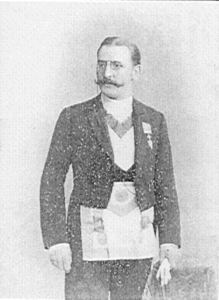 League, one of several early socialist movements emerging in England. He was expelled the following year due to accusations of operating as a spy for the Prussian police (despite scant evidence) (Howe and Möller 1978). During the 1890s, Reuss moved in several esoteric and masonic groups. [Image at right] This is where Reuss met Carl Kellner, whom Reuss later claimed wished to create an “Academia Masonica” uniting all masonic degrees and systems (Reuss 1912:15). Around the year 1900, Reuss obtained charters to establish several high-degree masonic rites in Germany via Gérard Encausse (alias Papus, 1865–1916), founder of the Martinist Order; William Wynn Westcott (1848–1925), Freemason and co-founder of the Hermetic Order of the Golden Dawn; and the Freemason John Yarker (1833–1913). In 1902, Reuss began issuing the periodical Oriflamme as a vehicle for his ideas (Höwe and Möller 1978; Kaczynski 2012).
League, one of several early socialist movements emerging in England. He was expelled the following year due to accusations of operating as a spy for the Prussian police (despite scant evidence) (Howe and Möller 1978). During the 1890s, Reuss moved in several esoteric and masonic groups. [Image at right] This is where Reuss met Carl Kellner, whom Reuss later claimed wished to create an “Academia Masonica” uniting all masonic degrees and systems (Reuss 1912:15). Around the year 1900, Reuss obtained charters to establish several high-degree masonic rites in Germany via Gérard Encausse (alias Papus, 1865–1916), founder of the Martinist Order; William Wynn Westcott (1848–1925), Freemason and co-founder of the Hermetic Order of the Golden Dawn; and the Freemason John Yarker (1833–1913). In 1902, Reuss began issuing the periodical Oriflamme as a vehicle for his ideas (Höwe and Möller 1978; Kaczynski 2012).
Also embroiled in the neo-Gnostic movement of the time, Reuss attended a spiritualist masonic conference organized by Papus in Paris in 1908. There, Reuss may have been ordained bishop of Jean Bricaud’s (1881–1934) l’Église Catholique Gnostique (later l’Église Gnostique Universelle). Bricaud (formerly a bishop of Jules Doinel’s (1842–1902) Gnostic Church) had broken away in 1907 to form his own church, supported by Papus and Louis-Sophrone Fugairon (b. 1846). Reuss later established a German branch of the church titled Die Gnostische Katolische Kirche (G.K.K.) (Toth 2005).
In 1910, Reuss granted a charter for Yarker’s Antient and Primitive Rite to Aleister Crowley (Reuss 1906 [1910]; Crowley 1989:628–629). Born in 1875 to parents who were members of the Plymouth Brethren, a dispensationalist 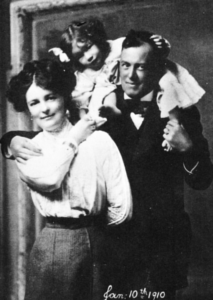 Christian sect, Crowley was no novice to esoteric activity. In 1898, he had joined the Hermetic Order of the Golden Dawn in London, rising quickly through the grades. His involvement with the order ended in 1900. In 1904, on honeymoon with his first wife Rose (née Kelly, 1874–1932), [Image at right] Crowley was visited by a discarnate entity named Aiwass, whom Crowley considered to be a messenger of the god Horus. Over three days, Aiwass dictated a text to Crowley: The Book of the Law, later given the technical title Liber AL vel Legis (Crowley 2004). Though initially skeptical of the book’s message, Crowley eventually accepted his status as prophet of a new religion: Thelema (Greek for “will”), of which The Book of the Law became the central sacred text. In 1907, Crowley and his former Golden Dawn mentor George Cecil Jones (1873–1960) founded the Order of the Silver Star or A\A\, which drew on the degree structure and ritual magical practices of the Golden Dawn combined with yogic techniques Crowley had learned travelling in Asia (Crowley 1994). Crowley also made study of the “Holy Books of Thelema” part of the A\A\ curriculum (Crowley 1909). Like Reuss, Crowley was a periodical publisher, having issued The Equinox as a vehicle of A\A\ since 1909.
Christian sect, Crowley was no novice to esoteric activity. In 1898, he had joined the Hermetic Order of the Golden Dawn in London, rising quickly through the grades. His involvement with the order ended in 1900. In 1904, on honeymoon with his first wife Rose (née Kelly, 1874–1932), [Image at right] Crowley was visited by a discarnate entity named Aiwass, whom Crowley considered to be a messenger of the god Horus. Over three days, Aiwass dictated a text to Crowley: The Book of the Law, later given the technical title Liber AL vel Legis (Crowley 2004). Though initially skeptical of the book’s message, Crowley eventually accepted his status as prophet of a new religion: Thelema (Greek for “will”), of which The Book of the Law became the central sacred text. In 1907, Crowley and his former Golden Dawn mentor George Cecil Jones (1873–1960) founded the Order of the Silver Star or A\A\, which drew on the degree structure and ritual magical practices of the Golden Dawn combined with yogic techniques Crowley had learned travelling in Asia (Crowley 1994). Crowley also made study of the “Holy Books of Thelema” part of the A\A\ curriculum (Crowley 1909). Like Reuss, Crowley was a periodical publisher, having issued The Equinox as a vehicle of A\A\ since 1909.
In 1912, Crowley and Reuss again crossed paths. Crowley claims Reuss sought him out at his London home, accusing Crowley of disseminating the “supreme secret” of Reuss’s Ordo Templi Orientis, associated with the IX° of the order. As a result, Reuss stated, Crowley must be initiated into the order and 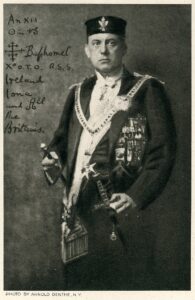 ceremonially sworn to secrecy. Crowley claimed to have retorted that he, ignorant of the order’s secret, could hardly be guilty of revealing it, to which Reuss responded by indicating a passage from Crowley’s The Book of Lies (first published in 1912, see Crowley 1980). Crowley describes how realization dawned on him. On April 21, Reuss thus conferred the IX° on Crowley, appointing him National Grand Master of OTO in Great Britain and Ireland (Crowley 1989:709–10). [Image at right] Reuss also appointed Crowley OTO representative for the U.S.. Parts of Crowley’s account are called into question by the lack of evidence of OTO existing as a membership organization prior to 1912. Though the order’s first constitution is dated to January 22, 1906, the document was likely produced closer to 1912, and it is thus reasonable to assume that OTO as a functioning organization emerged from Reuss’s and Crowley’s collaboration and mainly from 1912 on (cf. Howe and Möller 1978).
ceremonially sworn to secrecy. Crowley claimed to have retorted that he, ignorant of the order’s secret, could hardly be guilty of revealing it, to which Reuss responded by indicating a passage from Crowley’s The Book of Lies (first published in 1912, see Crowley 1980). Crowley describes how realization dawned on him. On April 21, Reuss thus conferred the IX° on Crowley, appointing him National Grand Master of OTO in Great Britain and Ireland (Crowley 1989:709–10). [Image at right] Reuss also appointed Crowley OTO representative for the U.S.. Parts of Crowley’s account are called into question by the lack of evidence of OTO existing as a membership organization prior to 1912. Though the order’s first constitution is dated to January 22, 1906, the document was likely produced closer to 1912, and it is thus reasonable to assume that OTO as a functioning organization emerged from Reuss’s and Crowley’s collaboration and mainly from 1912 on (cf. Howe and Möller 1978).
A British branch of OTO, “Mysteria Mystica Maxima” or M\M\M\, was established in London on June 1, 1912 (Reuss 1912:14). In September 1912, Reuss issued a “Jubilee edition” of Oriflamme, announcing OTO and revealing the nature of the order’s supreme secret: sexual magic, claimed as the key to all Hermetic and masonic systems (Reuss 1912:21). Concurrently, the September 1912 issue of Crowley’s The Equinox announced an “Order of Oriental Templars” and its British branch, M\M\M\. Though it is unclear whether Reuss had consecrated Crowley as bishop of his own Gnostic Catholic Church, Crowley’s announcement of OTO also mentioned the “Gnostic Catholic Church” as a spiritual antecedent to the order (Crowley 1912).
From the point of its official launch, OTO admitted men and women on equal terms. Though the order had this in common with several other contemporary occult societies, including the Golden Dawn and the Theosophical Society, the policy of initiating women distinguished OTO from its masonic roots. The decision to admit women can likely be linked to the order’s sex magical 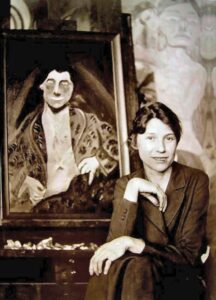 teachings. From the outset, several women held executive offices within the order, including Crowley’s first Grand Secretary General, Vittoria Cremers, and succeeding Secretaries, Leila Waddell (1880–1932) and Leah Hirsig (1883–1975) (cf. Hedenborg White 2021b). [Image at right]
teachings. From the outset, several women held executive offices within the order, including Crowley’s first Grand Secretary General, Vittoria Cremers, and succeeding Secretaries, Leila Waddell (1880–1932) and Leah Hirsig (1883–1975) (cf. Hedenborg White 2021b). [Image at right]
After his induction into OTO, Crowley proceeded to reshape the order. Dissatisfied with Reuss’s initiation rituals, Crowley with Reuss’s support revised the initiations up until the VI°. In Moscow in 1913, Crowley also penned a neo-Gnostic, Eucharistic ritual for the order: “Ecclesiæ Gnosticæ Catholicæ Canon Missæ” or the Gnostic Catholic Mass, which Crowley intended to communicate OTO’s central, sex magical secret (Crowley 1989:714; Crowley 2007:247–70). The Latinized name Ecclesia Gnostica Catholica had not previously been in general use, though Crowley’s adoption of this terminology clearly links the ritual to Reuss’s neo-Gnostic interests. The ritual centers on the veneration of the masculine and feminine principles and their erotic union (see Rituals/Practices for further information). The order also expanded geographically around this time. On December 20, 1913, Crowley issued a charter to his student James Thomas Windram (1877–1939) for South Africa, leading to the formation of two lodges. On November 15, 1915, Windram in turn granted a charter for Australia to Frank Bennett (1868–1930) (Windram 1915).
Though Crowley had utilized sexual acts to attain spiritual purposes on several previous occasions (see e.g., Hedenborg White 2020:54; 76 n89), his collaboration with Reuss marked the beginning of a more systematic engagement with sexual magic; the use of sexual acts or energy to attain specific goals. From 1914 on, Crowley explored sexual magic with numerous partners both male and female, recording the experiments in his diary (e.g., Crowley 1983; Crowley 1996). He also penned instructional documents for OTO’s higher degrees (e.g., Crowley 1914a; 1914b). Briefly summarized, Crowley’s technique consisted of concentrating on a desired outcome and raising and focusing sexual energy, culminating at the point of orgasm with the “charging” of an appropriate mental image. The resulting genital fluids were subsequently consumed or, in some cases, used to anoint a material talisman. Sexual magic was initially linked to the OTO’s VIII° and IX°, associated with autoerotic exercises and heterosexual intercourse, respectively. After performing a series of invocations with his lover and disciple Victor B. Neuburg (1883–1940) in 1914 in Paris, Crowley added an XI°. This degree is generally held to be associated with anal sex, which Crowley performed with both male and female partners (Crowley 1983: e.g., 53–64; Crowley 1998:343–409; cf. Bogdan 2006:218). In 1915, Crowley formally introduced Thelema into the branches of OTO under his jurisdiction (cf. Bogdan 2021:34).
During World War I, Crowley settled in the U.S., while Reuss relocated to Switzerland. In January 1917, Reuss announced the establishment of OTO’s headquarters in the form of an Anational Grandlodge in the progressive, utopian commune Monte Verità near Ascona, Switzerland (Howe & Möller 1978; Green 1987). In August that year, Reuss hosted an “OTO Anational Congress,” which featured a special reading of Crowley’s Gnostic Mass (Reuss 1917; Adderley 1997:245). Reuss also undertook a translation of The Book of the Law into German (Reuss n.d. [1917]), and in 1918 issued a modified German translation of the Gnostic Mass under the auspices of OTO (Reuss 1997:226–38; cf. Hedenborg White, forthcoming). The adoption of the Gnostic Mass as a central ritual established Ecclesia Gnostica Catholica (EGC) as a Thelemic organisation and marked a break with previous forms of Gnostic revivalism.
1918 marked the first English-language publication of the Gnostic Mass in The International (Crowley 1918). Around this time, Crowley again undertook a major revision of the OTO initiation rituals for 0°–III° to further distinguish the order from its masonic origins (Starr 2003:20–24; 98–100). On the spring equinox (March 21), 1919, Crowley resumed publication of his periodical The Equinox after a five-year silence. This was part of a larger publishing endeavor undertaken with the support of Detroit-based Freemason Albert W. Ryerson (1872–1931) and his mistress Bertha Bruce (b. 1888/1889), who also became Crowley’s lover. Commonly called the “blue” Equinox due to the color of its cover, The Equinox III (1) represents a benchmark in OTO history (cf. Kaczynski 2019:1–16). It comprises several key documents detailing the organization and mission of OTO, including Crowley’s revised manifesto for the order and a very slightly modified version of the Gnostic Mass that has since become canonical (Crowley 1919).
Crowley returned to Europe in December 1919. By the summer of 1921, his relationship with Reuss had become strained. Though Crowley later claimed an increasingly mentally unwell Reuss abdicated his position around this time, asking Crowley to take over as Outer Head of the Order (OHO), there are no surviving documents to prove this claim (quoted in Starr 2003: 110–13, 363). Reuss died in 1923, leaving the question of successorship unanswered. In 1924, Crowley formally accepted the office of OHO with the support of two of the remaining National Grand Masters: Charles Stansfeld Jones (1886–1950), who held a multinational charter for North America, and Heinrich Tränker (1880–1956), who held a national charter for Germany. It appears that all three were unaware, at the time, that Reuss in 1921 had issued a national charter for Denmark to Carl William Hansen (alias Ben Kadosh, 1872–1936) (Reuss 1921). Hansen’s successor Grundal Sjallung (1875–1976) contacted Crowley in 1938, believing that OTO had ceased to operate internationally.
With the aid of a close circle of followers, Crowley sought to defend his authority at a conference of occult leaders hosted by Tränker at his home in Weida, Germany, during the summer of 1925. The participants held mixed feelings towards Crowley. While Tränker’s secretary and publisher Karl J. Germer (1885–1962) sided with Crowley, the conference precipitated a schism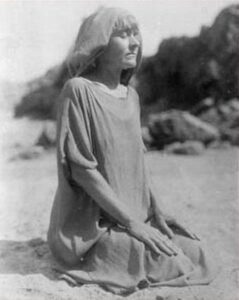 between Crowley and Tränker (Lechler 2013; Kaczynski 2010:418–23; for further details, see Issues/Challenges).
between Crowley and Tränker (Lechler 2013; Kaczynski 2010:418–23; for further details, see Issues/Challenges).
Coincident with the apparent rise of totalitarianism in Europe, Crowley decided to focus his efforts on establishing OTO in the U.S. Wilfred Talbot Smith (1885–1957), formerly active as a member of OTO in Vancouver, Canada, and Jane Wolfe (1875–1958), [Image at right] a long-time friend and student of Crowley’s who had resided with him in Europe, proceeded to establish the Agape Lodge of OTO in Los Angeles, California, in 1935. After suffering interment in a Nazi concentration camp, Germer emigrated to the U.S. in 1941. On July 18, Crowley indicated Germer as the 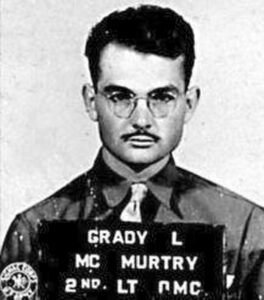 next OHO of OTO (Crowley 1941). The same year, engineering student Grady Louis McMurtry (1918–1985) [Image at right] was initiated into the Agape Lodge. McMurtry had spent time with Crowley in England during WWII while being stationed there as a soldier. In 1942, the Agape Lodge relocated to Pasadena at the behest of its new lodge master, jet fuel engineer John “Jack” Whiteside Parsons (1914–1952). In the spring of 1946, Crowley authorized McMurtry (under his magical name Hymenaeus Alpha) to take control of OTO in California in case of an emergency (Crowley 1946). By the end of WWII, the Agape Lodge was the only active OTO body in the world (Starr 2003: passim).
next OHO of OTO (Crowley 1941). The same year, engineering student Grady Louis McMurtry (1918–1985) [Image at right] was initiated into the Agape Lodge. McMurtry had spent time with Crowley in England during WWII while being stationed there as a soldier. In 1942, the Agape Lodge relocated to Pasadena at the behest of its new lodge master, jet fuel engineer John “Jack” Whiteside Parsons (1914–1952). In the spring of 1946, Crowley authorized McMurtry (under his magical name Hymenaeus Alpha) to take control of OTO in California in case of an emergency (Crowley 1946). By the end of WWII, the Agape Lodge was the only active OTO body in the world (Starr 2003: passim).
Aleister Crowley died in Hastings on December 1, 1947. The Agape Lodge dissolved the following year. While OTO membership activities subsequently dwindled in North America for a number of years, Germer supervised the publication of some of Crowley’s writings and collaborated with Crowley’s friend Gerald Yorke (1901–1983) to preserve letters and documents by Crowley and his followers (Germer 2016; Kaczynski 2010:553–54).
Karl Germer died in West Point, California, on October 25, 1962. In the aftermath of his passing, several persons made claims to successorship, including the British occultist Kenneth Grant (1924–2011), a student of Crowley’s who had been the latter’s secretary late in life; Herman Metzger (1919–1990), who led a Swiss branch of the order; and the Brazilian Thelemite Marcelo Ramos Motta (1931–1987). The strongest claim to successorship, and the only one to have been legally recognized, was that of Grady McMurtry. Learning of Germer’s death in 1968, McMurtry acted on his previous authorizations from Crowley (e.g., Crowley 1946) and moved to reestablish the order with the aid of former Agape Lodge members Phyllis Seckler (1917–2004) and Helen Parsons Smith (1910–2003). In 1977, McMurtry chartered Thelema Lodge in Berkeley, California, as the Grand Lodge of the reestablished OTO. On March 20, 1979, OTO was incorporated as a religious non-profit under California law. On July 12, 1985, the U.S. District Court of Northern California ruled in favor of McMurtry’s OTO, establishing it as the successor to Crowley’s organization and granting it the exclusive copyrights to Crowley’s works. McMurtry died on the day the court ruling was announced (Wasserman 2012).
As McMurtry did not name a successor, the task of choosing the next OHO was delegated to the remaining IX° members of the order. On September 21, 1985, William Breeze (b. 1955) was chosen as acting OHO under the name Hymenaeus Beta. OTO has grown considerably under Breeze’s leadership: 1996 witnessed the incorporation of the International Headquarters of OTO, with the United States Grand Lodge (USGL) as a subordinate body, and additional grand lodges have since been established in the UK (2005), Australia (2006), Croatia (2014), and Italy (2014). On October 10, 2014, Breeze was unanimously elected de jure OHO by the order’s five National Grand Masters.
DOCTRINES/BELIEFS
A discussion of the teachings of OTO necessitates a demarcation between the order’s first years of existence and its development under Crowley’s increasing stewardship and after. As noted, Reuss declared the order’s initial agenda to be the union of masonic and Hermetic systems via the key, sexual magic. Though the exact nature of Reuss’s teachings on sexual magic prior to his collaboration with Crowley is unclear, previous scholarship has identified three distinct sources of inspiration. Firstly, the Hermetic Brotherhood of Luxor, whose 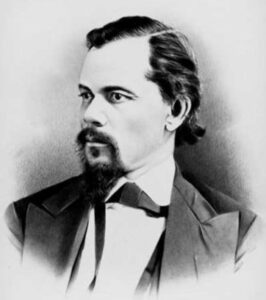 practices encompassed the sex magical teachings of physician, abolitionist, and spiritualist medium Paschal Beverly Randolph (1825–1875) (Deveney 1997). [Image at right] Randolph’s ideas may have reached Reuss indirectly via Carl Kellner and the Hermetic Brotherhood of Light, with which Reuss claimed Kellner had been in contact (Reuss 1912:15; Godwin et al. 1995). A second source of inspiration for Reuss was eighteenth and nineteenth-century Phallicism or Phallism, as propagated by Richard Payne Knight (1751–1824), Sir William Jones (1746–1794), and Hargrave Jennings (1817–1890), whose work Reuss partly plagiarized in the book Lingam-Yoni (Reuss 1906; cf. Kaczynski 2012:246–8). The core notion of Phallism was that the original religion of humankind consisted of the worship of the regenerative organs of both sexes. Reuss envisioned OTO as a vehicle for a reinstated cult of the Phallus (cf. Bogdan 2006; 2021:33–36). A third source of influence for Reuss was the Belgian Freemason and spiritualist Georges Le Clément de Saint-Marcq (1865–1956) and his ideas about spermatophagy (consumption of semen) as the true Eucharist established during the Last Supper (Pasi 2008; Reuss 1993:56–57).
practices encompassed the sex magical teachings of physician, abolitionist, and spiritualist medium Paschal Beverly Randolph (1825–1875) (Deveney 1997). [Image at right] Randolph’s ideas may have reached Reuss indirectly via Carl Kellner and the Hermetic Brotherhood of Light, with which Reuss claimed Kellner had been in contact (Reuss 1912:15; Godwin et al. 1995). A second source of inspiration for Reuss was eighteenth and nineteenth-century Phallicism or Phallism, as propagated by Richard Payne Knight (1751–1824), Sir William Jones (1746–1794), and Hargrave Jennings (1817–1890), whose work Reuss partly plagiarized in the book Lingam-Yoni (Reuss 1906; cf. Kaczynski 2012:246–8). The core notion of Phallism was that the original religion of humankind consisted of the worship of the regenerative organs of both sexes. Reuss envisioned OTO as a vehicle for a reinstated cult of the Phallus (cf. Bogdan 2006; 2021:33–36). A third source of influence for Reuss was the Belgian Freemason and spiritualist Georges Le Clément de Saint-Marcq (1865–1956) and his ideas about spermatophagy (consumption of semen) as the true Eucharist established during the Last Supper (Pasi 2008; Reuss 1993:56–57).
OTO was fundamentally restructured by Crowley’s introduction and increasing emphasis on Thelema and its principles as put forth in its core sacred text, The Book of the Law. Its central tenet “Do what thou wilt shall be the whole of the Law” was prefigured in Francois Rabelais’s Gargantua et Pantagruel (1532), which features an “Abbaye du Thélème.” Rather than an injunction to act on each impulsive desire, Crowley interpreted “Do what thou wilt” as referring to the duty of each person to discover and accomplish their “true Will”, which he believed to be the unique purpose of each individual life (e.g., Crowley 1974:129–30). The related maxim: “Love is the law, love under will” (foreshadowed by St. Augustine’s dictum: “Love, and do what thou wilt”) was interpreted by Crowley to mean that the nature of the true will is love, and that each intentional act is an act of union (i.e., love) with creation (e.g., Crowley 1974:163–64; Crowley 2007b). Crowley viewed magic (or “Magick,” as he preferred to spell it) as the key to discovering and honing one’s will, defining it as “the Science and Art of causing Change to occur in conformity with Will” (Crowley 1994:128). Between 1907 and 1911, Crowley produced several additional inspired writings, which together with The Book of the Law comprise the “Holy Books of Thelema,” the canon of Thelemic texts (Crowley 1988; 1998).
Crowley considered the reception of The Book of the Law to mark the beginning of a new age, which he designated the Aeon of Horus. In his notion of aeons (approximately 2,000 year-periods correlating with different stages in the spiritual evolution of humanity), Crowley was inspired both by his upbringing in the Plymouth Brethren and its dispensationalist teachings, and by Frazerian theories of religious evolution (Bogdan 2012; 2021:16–20). The first aeon Crowley mentions by name is the Aeon of Isis, which he associates with matriarchal prehistory and the veneration of a great goddess representing the natural world. Isis was superseded, according to Crowley, by the Aeon of Osiris, characterized by patriarchal monotheism, the elevation of spirit over matter, and worship of various embodiments of the “Dying God,” such as Christ, Dionysus, or Orpheus. The reign of Horus, divine offspring of Isis and Osiris, would be characterized by individualism, the shattering of old illusions, and the union of matter and spirit (Crowley 1936; Crowley 1974:137f; 271ff).
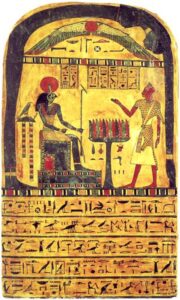
Erotic imagery is central to Thelemic ontology, which is conceptualized as a dialectic between the goddess Nuit, envisioned as the night sky and representing limitless space and potential, and her consort Hadit, the infinitely condensed life-force of each individual. Their ecstatic union gives rise to Ra-Hoor-Khuit (a form of the god Horus), [Image at right] associated with the sun and the liberating energies of the new aeon (Crowley 1974; 2004, passim). This triad is reflected in The Book of the Law, whose three chapters are ascribed to Nuit, Hadit, and Ra-Hoor-Khuit, respectively. The Thelemic pantheon also includes the goddess Babalon and her consort Chaos. Based on a favorable re-interpretation of the Biblical Whore of Babylon (Rev. 17), Crowley identified Babalon with the magical formula of openness or receptivity towards all aspects of creation, and the sacredness of liberated (and particularly feminine) sexuality (Hedenborg White 2020, passim). This Thelemic pantheon is celebrated in Crowley’s Gnostic Mass (Crowley 2007).
RITUALS/PRACTICES
OTO offers a series of staged initiation rituals through which the initiate is gradually made privy to esoteric secrets. As noted above, the masonic elements that characterized the early OTO initiations were gradually toned down under Crowley’s influence. Sexual magic is taught in the order’s higher degrees. The present-day OTO’s initiatory structure (organized under M\M\M\ (see below)) comprises thirteen numbered degrees from O° to XII° and eight intermediary degrees. The degrees are organized in three “Grades” or “Triads”: Man of Earth, Lover, and Hermit. The Man of Earth degrees are correlated with the chakra system and represent a dramatized progression of the soul through incarnation: conception, birth, life, death, and beyond (see Crowley 1982:122–24: Crowley 1990:193). The 0° (Minerval) degree is equivalent to the status of “honored guest”, while the first degree (I°) confers full membership. Two degrees are primarily administrative: X° marks a National Grand Master, and XII° is held exclusively by the OHO.
Aside from initiations, larger OTO local bodies are expected to provide regular celebrations of the Gnostic Catholic Mass, considered to be the “central ceremony of [OTOs] public and private celebration” (Crowley 1989:714). The Gnostic Mass is performed under the auspices of Ecclesia Gnostica Catholica (EGC) and is often open to the public, serving an important function in introducing Thelema to new seekers as well as providing a spiritual experience and opportunity for socializing. Though Crowley claimed to have written the Gnostic Mass under the inspiration of the liturgy of St. Basil’s Cathedral, his Eucharistic ritual is structurally more like the Tridentine mass of the Roman Catholic Church. Direct parallels include the recitation of a creed; an acknowledgment of spiritual predecessors; recitation of collects; blessings for the dead; and the dissemination of a Eucharist of wine and bread (so-called Cakes of Light). The Gnostic Mass celebrates the Thelemic worldview and divine pantheon. Mirroring the Thelemic view of divinity as comprising both masculine and feminine aspects, the Gnostic Mass is performed by a priest and priestess aided by a deacon and two auxiliary officers known as “children.” Priest and priestess collaboratively invoke the masculine and feminine divine and prepare the Eucharist by enacting a “Mystic Marriage,” a symbolic sexual union where the priest’s lance is lowered into a wine-filled cup (Crowley 2007:247–70).
In addition to performances of the Gnostic Mass, the contemporary EGC confers lay membership via baptism and confirmation and performs weddings, last rites, and clerical ordinations. Many larger OTO bodies offer social gatherings, study groups, workshops, and classes on Thelema in addition to ritual activities. It is common for local bodies to celebrate the solstices, equinoxes, and some or all the “Thelemic Holidays” marking important dates in the life of Aleister Crowley. Such events are frequently open to non-initiates, and this combined with the fact that many larger OTO bodies maintain permanent temple facilities gives the organization a more public presence than many other initiatory orders.
A large-scale study of the individual esoteric practices of OTO members is lacking. However, tentative conclusions can be drawn based on the author’s observations. Though not a formal requirement, many (if not most) OTO members maintain some form of personal magical practice. Though A\A\ is formally distinct from OTO, dual affiliation has been relatively common since Crowley’s lifetime and remains so today. Even among OTO members who are not affiliated with A\A\, many adopt elements of the A\A\ system into personal practice. This includes, but is not limited to, keeping a magical diary (a practice Crowley taught his disciples); daily salutations to the sun as prescribed in Crowley’s “Liber Resh vel Helios” (Crowley 1994:645); regular rituals in service of magical hygiene such as the “Lesser Ritual of the Pentagram” or Crowley’s “Star Ruby” ritual (Crowley 1980:60); and yogic and meditational practices. Though sexual magic is traditionally linked to the higher degrees of OTO, eclectic and individualized sex magical practices appear relatively common among rank-and-file members (cf. Hedenborg White 2020:196, passim).
ORGANIZATION/LEADERSHIP
Counting approximately 4,000 members, OTO is the world’s most populous Thelemic order. As of January 2022, it is organized on five continents in more than thirty countries, with over 150 local bodies worldwide. The order’s International Headquarters (IHQ) is administered by the Supreme Council, comprising the three principal international officers of the order. These are: (1) the Outer Head of the Order, also known as Frater (or Soror) Superior or Caput Ordinis, (2) the Secretary General, or Cancellarius, and (3) the Treasurer General, or Quaestor. IHQ presides over National Grand Lodges in the United States, United Kingdom, Australia, Croatia, and Italy. Of these, the United States Grand Lodge (USGL) is the largest and most active, comprising roughly a third of global membership. National Grand Lodges are headed by a National Grand Master General, holding the degree of Rex Summus Sanctissimus or Supreme and Most Holy King (X°). Countries without a National Grand Lodge may operate as National Sections under the supervision of a Frater Superior’s Representative (FSR). At the Man of Earth level, local bodies (organized as Camps, Oases, and Lodges, and differentiated by the initiations and activities they are expected to offer) are operated either under the jurisdiction of a National Grand Lodge or directly under IHQ. Additional forms of organization include so-called Chapters of Rose Croix, formed by members of the Lover Grade, and Guilds, which center on promoting a particular profession, occupation, or science. There are no official statistics on OTO membership or leadership by gender, though observations suggest a slight male majority among rank-and-file members (Hedenborg White 2020:198).
OTO encompasses two constituent rites: Mysteria Mystica Maxima (M\M\M\) and Ecclesia Gnostica Catholica (EGC). Originally denoting Crowley’s British branch of OTO, M\M\M\ today presides over OTO initiations worldwide. Though originating as an independent organization (and existing as an autonomous, religious non-profit between 1979 and 1985) EGC is today integrated in OTO as its ecclesiastical arm. The office of patriarch (or matriarch) of EGC is held by the OHO, and the primacy of the church comprises the National Grand Masters of the order. EGC also comprises episcopate, priesthood (priests and priestesses), and diaconate. Though baptism and confirmation in EGC do not require OTO membership, ordination to the diaconate, priesthood, and episcopate require particular OTO degrees.
ISSUES/CHALLENGES
The issue of succession and leadership has posed recurring challenges throughout OTO’s history. As noted above, Reuss’s death was followed by disagreements as to the rightful successor to the office of OHO. The issue was broached at the Conference of Grand Masters, a gathering of occult leaders hosted by Heinrich Tränker at his home in Weida, Germany, 1925. Also present for the gathering were Crowley’s long-term disciple Martha Küntzel (1857–1941) and her lover, Otto Gebhardi; Tränker’s secretary and publisher, Karl Germer; Tränker’s wife, Helene: members of Tränker’s Pansophical movement, Albin Grau (also a member of Crowley’s A\A\) and Eugen Grosche (1888–1964); Henri Birven (1883–1969); and the artist Oskar Hopfer, as well as Crowley and his disciples Leah Hirsig, Norman Mudd (1889–1934), and Dorothy Olsen (b. 1892). The conference was hardly an unequivocal success for anyone involved. While Küntzel and Germer supported Crowley, Tränker, Grau, Birven, and Grosche agreed to keep the Pansophical movement independent of Crowley’s leadership. Tränker subsequently came to reject Crowley (e.g., Lechler 2013), as did Mudd and Hirsig (cf. Hedenborg White 2021b). Bringing together several ex-Pansophists, Grosche went on to found Fraternitas Saturni, which regarded Crowley as a prophet but maintained its independence as an order.
As noted above, the issue of succession resurfaced after Karl Germer’s death in 1962. McMurtry’s claim to OTO headship was challenged by Hermann Metzger, head of a Swiss branch of the order that traced its lineage to Reuss, and which regularly performed Crowley’s Gnostic Mass (Giudice 2015). Following Germer’s death, the members of Metzger’s group voted to elect him as OHO (Weddingen 1963). Lacking authority as per the OTO constitution, the results of this election were not accepted by order members outside of Switzerland. An alternate claim to OTO headship was made by Kenneth Grant, who had served as Crowley’s secretary late in the latter’s life. In 1948, after Crowley’s death, Grant was accepted as a IX° initiate of OTO, and later received a charter from Germer to operate an OTO body in London. In 1955, Grant issued a manifesto announcing the foundation of his “New Isis Lodge” as a body of OTO (Grant 1955). The manifesto put forth that the earth was under the influence of a “transplutonic” planet named Isis, and that the task of the New Isis Lodge was to channel its influence. Germer took issue with Grant’s ideas and expelled the latter from OTO. Grant, however, continued to operate the New Isis Lodge until 1962. From the late 1960s, Grant claimed to be head of a “Typhonian” OTO (referencing the idea of a Typhonian tradition, which Grant elaborated in his nine “Typhonian Trilogies,” published 1972–2002). In 2011, the name of this organization was changed to the Typhonian Order (Bogdan 2015).
The most substantial challenge to McMurtry’s leadership was brought by the Brazilian Thelemite Marcelo Ramos Motta (1931–1987), a former A\A student of Germer’s who had been publishing new editions of Crowley’s works, often with his own commentaries. Upon learning that Crowley had bequeathed his copyrights to OTO, Motta enlisted his student James Wasserman (1948–2020), then an employee of the Samuel Weiser bookstore in New York, to aid him in securing the rights. However, Wasserman ultimately backed McMurtry’s claim. The ensuing hostility led Motta in 1981 to sue Weiser for copyright infringement, positing his own Society Ordo Templi Orientis as the continuation of the Crowley-Germer OTO. As mentioned above, the U.S. District Court of Northern California eventually ruled in favor of McMurtry’s OTO. Today, these issues are largely resolved, and little controversy remains as to the religious non-profit Ordo Templi Orientis Inc. being the legal successor to the Crowley-Germer organization (Wasserman 2012).
The reception of Crowley’s ideas has been affected by larger societal changes, including feminism and LGBTQ rights advocacy. The Thelemic milieu (including OTO as well as other, smaller Thelemic orders, networks, and solitary practitioners) since at least the 1990s has witnessed an increasing proliferation of publications and initiatives (including conferences, podcasts, newsletters, and social media campaigns) aimed at highlighting women’s voices and experiences. The organization of Thelemic Women’s Conferences (in 2006, 2008, and 2016) can be noted as important benchmarks. In the U.S., many larger OTO bodies have regular meetings for women members of the order. The U.S. branch of EGC, which is the largest and most organized, shows awareness of ongoing conversations about gender identity, and has developed EGC policy to accommodate trans priests and priestesses in the Gnostic Mass, as well as non-binary and/or genderqueer identified EGC clergy (cf. Hedenborg White 2021a:189–90).
IMAGES
Image #1: Carle Kellner.
Image #2: Theodor Reuss .
Image #3: The Crowley family.
Image #4: Aleister Crowley as Baphomet X°.
Image #5: Leah Hirsig.
Image #6: Jane Wolfe.
Image #7: Grady Louis McMurtry.
Image #8: Paschal Beverly Randolph.
Image #9: The Stele of Ankh-af-na-Khonsu.
REFERENCES
Adderley, J. 1997. “Programme du Congrès Cooperatif Anational de la Confrérie des Illuminés Hermétiques à Monte Verità sur Ascona du 15 au 25 Août 1917.” P. 245 in Der Grosse Theodor-Reuss-Reader, edited by Peter R. König. München: Arbeitsgemeinschaft für Religions- und Weltanschauungsfragen.
Bogdan, Henrik. 2021. “Deus Est Homo: The Concept of God in the Magical Writings of the Great Beast 666 (Aleister Crowley).” Aries: Journal for the Study of Western Esotericism 21:13–42.
Bogdan, Henrik. 2015. “Kenneth Grant and the Typhonian Tradition.” Pp. 323–30 in The Occult World, edited by Christopher Partridge. New York: Routledge.
Bogdan, Henrik. 2012. “Envisioning the Birth of a New Aeon: Dispensationalism and Millenarianism in the Thelemic Tradition.” Pp. 89-106 in Aleister Crowley and Western Esotericism, edited by Henrik Bogdan and Martin P. Starr. New York: Oxford University Press.
Bogdan, Henrik. 2006. “Challenging the Morals of Western Society: The Use of Ritualized Sex in Contemporary Occultism.” The Pomegranate 8:211–46.
Crowley, Aleister. 2007a. “De Lege Libellum”. In Aleister Crowley, Pp. 40-42 in The Blue Equinox: The Equinox Vol. III No. I. San Francisco: Red Wheel/Weiser.
Crowley, Aleister. 2007b. “Liber XV: Ecclesiæ Gnosticæ Catholicæ Canon Missæ.” Pp. 247–70 in Aleister Crowley, The Blue Equinox: The Equinox Vol. III No. I,. San Francisco: Red Wheel/Weiser.
Crowley, Aleister. 2004. The Book of the Law: Liber Al vel Legis: With a Facsimile of the Manuscript as Received by Aleister and Rose Edith Crowley on April 8, 9, 10, 1904. E.v. Centennial Edition. York Beach, ME: Red Wheel/Weiser, 2004.
Crowley, Aleister. 1998. “The Paris Working.” Pp. 343–409 in The Vision and the Voice with Commentary and Other Papers, edited by Hymenaeus Beta. York Beach, Me: Samuel Weiser.
Crowley, Aleister. 1998. The Vision and the Voice with Commentary and Other Papers, edited by Hymenaeus Beta. York Beach, Me: Samuel Weiser.
Crowley, Aleister. 1996. The Magical Diaries of Aleister Crowley: Tunisia 1923. Edited by Stephen Skinner. York Beach, ME: S. Weiser.
Crowley, Aleister. 1994. Magick: Liber ABA, edited by Hymenaeus Beta. York Beach, ME.: S. Weiser.
Crowley, Aleister. 1990. “The Man of Earth Degrees and the Hindu Chakras.” In Aleister Crowley et al., The Equinox Vol. III No. 10, edited by Hymenaeus Beta. York Beach, ME: Samuel Weiser.
Crowley, Aleister, 1989. The Confessions of Aleister Crowley: An Autohagiography. London: Arkana.
Crowley, Aleister. 1983. The Magical Record of the Beast, 666: The Diaries of Aleister Crowley, 1914–1920. Edited by John Symonds and Kenneth Grant. London: Duckworth.
Crowley, Aleister. 1982. Magick without Tears. Edited by Israel Regardie. Phoenix, AZ: Falcon Press.
Crowley, Aleister. 1980. The Book of Lies: Which is Also Falsely Called Breaks. York Beach, ME: S. Weiser.
Crowley, Aleister. 1946 (March 22). Letter to Grady Louis McMurtry. OTO archives.
Crowley, Aleister. 1941. Appointment of Karl Germer as OHO. OTO archives.
Crowley, Aleister. 1936. The Equinox of the Gods. London: OTO.
Crowley, Aleister. 1919. The Equinox, Volume III, No. 1. Detroit, MI: Universal Publishing Company.
Crowley, Aleister. 1918. “Ecclesiæ Gnosticæ Catholicæ Canon Missæ.” The International 12: 70–74.
Crowley, Aleister. 1914a. “AGAPE vel Liber C vel AZOTH. Sal Philosophorum the Book of the Unveiling of the Sangraal Wherein It Is Spoken of the Wine of the Sabbath of the Adepts.” OS26, Gerald J. Yorke Collection, Warburg Institute, London.
Crowley, Aleister. 1914b.“Liber CDXIV: De Arte Magica.” Gerald J. Yorke Collection NS3, Warburg Institute.
Crowley, Aleister. 1914c. Manifesto of the M\M\M\ Issued by Order of L. Bathurst, Grand Secretary General. London: privately printed.
Crowley, Aleister. 1912. “Order of Oriental Templars: Mysteria Mystica Maxima.” Equinox I:vii–xv.
Crowley, Aleister. 1909. QELHMA [Thelema]. Three Volumes. London: privately printed.
Crowley, Aleister, and David Curwen. 2010. Brother Curwen, Brother Crowley: A Correspondence, edited by Henrik Bogdan. York Beach, ME: Teitan Press.
Deveney, John Patrick. 1996. Paschal Beverly Randolph: A Nineteenth-Century Black American Spiritualist, Rosicrucian, and Sex Magician. Albany, NY: SUNY Press.
Germer, Karl. 2016. Karl Germer: Selected Letters 1928–1962. Edited by David Shoemaker, Andrew Ferrell, and Stefan Voss. International College of Thelema.
Giudice, Christian. 2015. “Ordo Templi Orientis.” Pp. 277-282 in The Occult World, edited by Christopher Partridge. New York: Routledge.
Godwin, Joscelyn, Christian Chanel, and John Patrick Deveney, eds. 1995. The Hermetic Brotherhood of Luxor: Initiatic and Historical Documents of an Order of Practical Occultism. York Beach, Me.: S. Weiser.
Green, Martin. 1987. Mountain of Truth. The Counterculture Begins: Ascona 1900–1920. Hanover, NH: University Press of New England.
Hedenborg White, Manon. Forthcoming. “Mystery Translated: The Transmisson of Tradition in Theodor Reuss’s German Translation of the Gnostic Mass.” Oriflamme.
Hedenborg White, Manon. 2021a. “Double Toil and Gender Trouble? Performativity and Femininity in the Cauldron of Esotericism Research.” Pp. 182-200 in New Approaches to the Study of Esotericism, edited by Egil Asprem and Julian Strube. Leiden: Brill.
Hedenborg White, Manon. 2021b. “Proximal Authority: The Changing Role of Leah Hirsig in Aleister Crowley’s Thelema, 1919–1930.” Aries: Journal for the Study of Western Esotericism 21:69–93.
Hedenborg White, Manon. 2020. The Eloquent Blood: The Goddess Babalon and the Construction of Femininities in Western Esotericism. New York: Oxford University Press.
Hedenborg White, Manon. 2013. “To Him the Winged Secret Flame, to Her the Stooping Starlight: The Social Construction of Gender in Contemporary Ordo Templi Orientis”. The Pomegranate: International Journal of Pagan Studies 15:102–21.
Howe, Ellic, and Helmut Möller. 1978. “Theodor Reuss: Irregular Freemasonry in Germany, 1900–23,” Ars Quatuor Coronatorum 91:28–46.
Jennings, Hargrave. 1899. Phallism: A Description of the Worship of Lingam-Yoni in Various Parts of the World, and in Different Ages, with an Account of Ancient & Modern Crosses, Particularly of the Crux Ansata (or Handled Cross) and Other Symbols Connected with the Mysteries of Sex Worship. London: privately printed.
Kacynski, Richard. 2019. Panic in Detroit: The Magician and the Motor City. U.S.: Richard Kaczynski.
Kaczynski, Richard. 2012. Forgotten Templars: The Untold Origins of Ordo Templi Orientis. N.P: Richard Kaczynski.
Kaczynski, Richard. 2010. Perdurabo: The Life of Aleister Crowley. Second Edition. Berkeley, CA: North Atlantic Books.
Lechler, Volker. 2013. Heinrich Tränker als Theosoph, Rosenkreuzer und Pansoph. Bausteine zum okkulten Logenwesen. Stuttgart: Selbstverlag Volker Lechler.
Pasi, Marco. 2011. “The Knight of Spermatophagy: Penetrating the Mysteries of Georges Le Clément de Saint-Marcq.” Pp. 369–400 in Hidden Intercourse: Eros and Sexuality in the History of Western Esotericism, edited by Jeffrey Kripal and Wouter J. Hanegraaff. Leiden: Brill.
Pasi, Marco. 2005. “Ordo Templi Orientis.” Pp. 898–906 in Dictionary of Gnosis and Western Esotericism, edited by Wouter J. Hanegraaff. Leiden: Brill.
Reuss, Theodor. 1997. “Ecclesiae Gnosticae Catholicae Canon Missae. Die Gnostische Messe. Aus dem Original-Text des Baphomet übertragen in die deutsche Sprache von Merlin Peregrinus.” Pp. 226–38 in Theodor Reuss, Der Grosse Theodor-Reuss-Reader, edited by Peter R. König. München: Arbeitsgemeinschaft für Religions- und Weltanschauungsfragen.
Reuss, Theodor. 1993. “Parsival und das Enthüllte Grals-Geheimnis.” Pp. 56–76 in Der kleine Theodor-Reuss-Reader, edited by Peter R. König. München: Arbeitsgemeinschaft für Religions- und Weltanschauungsfragen, 1993.
Reuss, Theodor. 1921 (September 3). Charter to Carl William Hansen for OTO in Denmark. OTO archives.
Reuss, Theodor. n.d. [1917]. Letter to Aleister Crowley. OTO archives.
Reuss, Theodor. 1917 [January 22]. “Ordo Templi Orientis: Hermetic Brotherhood of Light. Anational Grandlodge & Mystic Temple: “Veritá Mistica,” or Ascona Manifesto,” OTO archives.
Reuss, Theodor, ed. 1912. I.N.R.I./Jubilaeums-Ausgabe der Oriflamme. Berlin; London: privately printed.
Reuss, Theodor. 1906 [1910]. Charter to Aleister Crowley for the Antient and Primitive Rite. OTO archives.
Reuss, Theodor [Pendragon]. 1906. Lingam-Yoni. Berlin: Verlag Willson.
Starr, Martin P. 2003. The Unknown God: W. T. Smith and the Thelemites. Bolingbrook, IL: Teitan Press.
Toth, Ladislaus. 2005. “Gnostic Church.” Pp. 400–403 in Dictionary of Gnosis and Western Esotericism, edited by Wouter J. Hanegraaff. Leiden: Brill.
Wasserman, James. 2012. In the Center of the Fire: A Memoir of the Occult 1966–1989. Lake Worth, FL: Ibis Press.
Weddingen, Dorothea. 1963 [May 25]. “Affidavit.” OTO archives.
Windram, James Thomas. 1915 (November 15). Charter to Frank Bennett for OTO in Australia. OTO archives.
Publication Date:
10 April 2022
